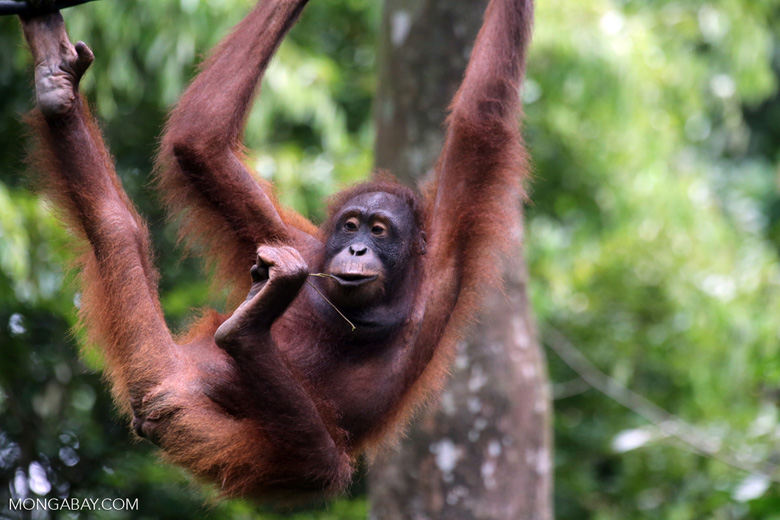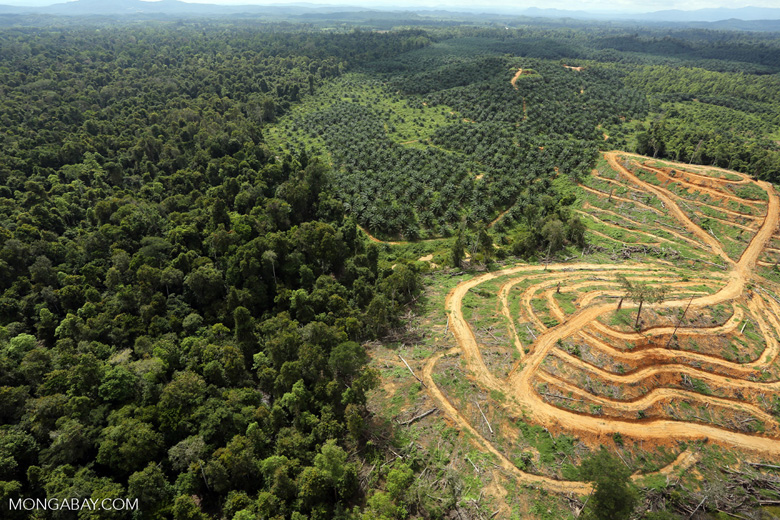- 1,500 orangutans now live in rescue centers located across Sumatra and Borneo, and many conservationists, along with the Indonesian government, want to return them to the wild as soon as possible. However, a new study poses a serious concern.
- Borneo’s three recognized orangutan subspecies — from three distinct regions — are thought to have diverged from each other 176,000 years ago, meaning that hybridization between them may result in negative genetic effects.
- If hybrid offspring reproduce, gene combinations beneficial to one lineage can be disrupted, causing poor health and reduced reproductive success. This “outbreeding depression” could threaten the survival of individuals and populations long-term.
- Some scientists do not agree with orangutan subspecies designations, and would rather see the animals returned to the wild quickly, no matter where. Others say genetic testing of rescued animals and reintroduction to a matching subspecies region will prevent hybridization, and would be the prudent approach.

An estimated 1,500 orangutans now live in rescue and rehabilitation centers located across Sumatra and Borneo. As habitat loss due to deforestation and forest fires continues, these institutions are struggling to keep up with demand.
Release into the wild is the ultimate, urgent, goal for most of these animals, but a new study warns that there could be serious genetic implications for the offspring of reintroduced animals — and orangutan populations in general — if those rescued from one region are released into a different region.
The study, led by primatologist Graham Banes, examined the genetic consequences when orangutans from different, divergent, subspecies interbreed. Borneo’s three recognized subspecies — from three distinct regions — are thought to have diverged from each other 176,000 years ago, meaning that hybridization between them may result in negative genetic effects. If hybrid offspring reproduce, combinations of genes that were beneficial for one lineage can be disrupted, resulting in poor health and reduced reproductive success, the researcher said. These effects, known as “outbreeding depression,” could threaten the survival of individuals and populations in the long-term.
To see whether these issues may have affected past reintroductions, Banes scoured 44 years of data on orangutan family history at the long-running rescue and rehabilitation program at Camp Leakey, in Borneo’s Tanjung Puting National Park. In combination with genetic analysis, Banes was able to identify all known descendants of two females of a non-native subspecies that had been reintroduced into the park in the 1970s. Back then subspecies were not recognized, and all orangutans were classified as a single species rather than the two (Sumatran and Bornean) recognized today. Between them, these two females, called Rani and Siswoyo, have had 22 known descendants; 15 are still alive.

On the face of it, reproduction had apparently not been a problem. But when Banes looked more closely, a striking — and intriguing — picture emerged. “Rani enjoyed the greatest reproductive success of any female at the site, with at least 14 descendants over three generations of offspring,” Banes told Mongabay. “Siswoyo, on the other hand, suffered the worst reproductive success you could imagine.”
Of five offspring, only three survived. One of these went on to produce three further offspring, only one of which survived beyond infancy. “I’ve lost count of the number of times that Siswoyo or her descendants have ended up on a surgical table for major veterinary procedures,” said Banes, who has been studying orangutans at Camp Leakey since 2008; he works with the Chinese Academy of Sciences and the Max Planck Partner Institute for Computational Biology in Shanghai, China.
“With data from just two individuals, we cannot possibly conclude that subspecies hybridization has caused these opposite phenomena,” Banes emphasized.
But he thinks that the risks are too great to ignore.
“It would be enormously irresponsible not to speculate… that Rani’s descendants might be reaping the benefits of greater genetic disparity, while Siswoyo’s [descendants] suffer — sometimes fatally — from outbreeding depression,” he went on. “Even Rani’s reproductive success may be the consequence of hybrid vigor, which could yet give way to outbreeding depression.”

Given that many hundreds of orangutan releases have already occurred in Tanjung Puting National Park alone, and that Rani’s male descendants “will have dispersed widely over the national park and reproduced prolifically with distant wild-born females… it’s entirely plausible that there are dozens or hundreds of subspecies hybrids all over the Park,” Banes explained.
“We simply don’t understand how this hybridization might affect wild populations — for better or for worse. But we cannot ignore the fact that hybridizing animals that have been geographically, genetically and reproductively isolated for tens of thousands of years may have unwanted consequences,” he concluded.
A similar story might affect other rescue centers, as it was not until the 1990s that taxonomic subspecies distinctions were made. Even now, orangutan taxonomy is controversial, with some arguing that the different subspecies shouldn’t be recognized after all, Banes said.
Those who subscribe to this view see no problem with releasing animals of differing geographic origins into varying regions. This approach looks even more practical in light of Indonesian government legislation decreeing that all orangutans should be released by the end of 2015 — a deadline that was impossible to meet.
“In my opinion, this is grossly irresponsible,” Banes said. “Perhaps it’s fine to mix Bornean orangutans from all over the island. But what if it’s not? What happens if, for the sake of short-term welfare, we’ve suddenly compromised the survival of reintroduced or wild populations?” he speculated. “The whole point of reintroduction is that the animals go on to independently survive and produce their own viable offspring. We could facilitate the total opposite if we don’t get this right — and we only get one go at this.”
Banes is working with the World Association of Zoos and Aquariums to see how captive-bred orangutans in zoos have fared in terms of health and reproduction, to try and better understand the possible implications of what he calls “cocktail” orangutans with a mixed genetic heritage. But until it can be shown conclusively that hybridization does, or doesn’t, cause problems, Banes thinks the risks must be borne in mind.
“We absolutely must err on the side of caution. We simply cannot ‘play God’,” he said.
“It is very realistic to genetically test orangutans before we reintroduce them, and that’s primarily all that needs to happen,” Banes stated, citing bureaucratic and technical obstacles as the main factors preventing this from happening. “It would be much easier, much faster and much more affordable if [the Indonesian government would] let samples out of the country for rapid analysis abroad.”
Rescued animals are just one small part of the ongoing race to save orangutans from extinction. “Almost 80 percent of wild individuals live outside of protected areas… in land that could [be] purchased or converted to oil-palm or otherwise deforested easily,” Banes said. “Protection and preservation of wild orangutan habitat should absolutely be the priority when compared with rehabilitation.”
But Banes sees reintroductions as important not only from a conservation standpoint, but also an ethical one. “As humans, we are responsible for displacing these animals, and we have a moral and ethical responsibility to return them to the wild.”
“[T]he solution to our current predicament is simple,” he asserted. “Genetically test orangutans in rehabilitation centers, repatriate them to the regions from which they came, and work to protect and conserve existing wild populations. If we do this right, there’s no reason why reintroduced orangutans can’t bolster wild populations in the future.”
Citation:
Banes, G.L., Galdikas, B.M.F, and Vigilant, L. (2016) Reintroduction of confiscated
and displaced mammals risks outbreeding and introgression in natural populations, as evidenced by orang-utans of divergent subspecies. Scientific Reports: 6:22026 DOI: 10.1038/srep22026

